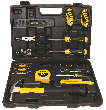Have you ever noticed just how different the temperature is in a basement? Either it is too hot, or way too cold when compared to the rest of the house. Surprisingly, the basement of a home can have a dramatic impact on your overall energy bill. Insulating basements properly can help to make this bill a little less stressful. You don't have to be a professional framer or insulator to start insulating basements. All you need to do is follow these simple instructions.
Materials:
- Foam board insulation
- 2 inch by 2 inch wood pieces of lumber
- 1 inch by 3 inch furring strips
- Construction adhesive
- Vapor barrier material
- 3d nails
- Masonry screws
- Particle resistant dust mask
- Utility knife
- Caulking gun
- Plumb line
- Hammer
- Circular saw
- Straightedge
- Drill and screwdriver bits
- Level
Procedure:
- Take measurements. Take measurements of all the walls that you will be insulating in your basement. These measurements are necessary to help you determine how much insulation you will need as well as how many furring strips you will need. Do all your measurements at least twice to make sure that they are as accurate as possible. Once you have your measurements, go to your local home improvement store and purchase enough 2 inch by 2 inch lumber, 1 inch by 3 inch furring strips, foam board insulation, and other materials necessary to complete the job.
- Install top plate. Cut a piece of 2 inch by 2 inch lumber to the length of one wall. Attach this piece of wood to top of the wall, flush against the ceiling. Attach the lumber to the ceiling along the joists (if they are exposed). Once attached, find the center, and place marks along the wood at 16 inch intervals. Repeat with all walls that need to be insulated.
- Install bottom plate. Install a 2 inch by 2 inch piece of lumber along the bottom of the wall in the same manner as you did with the top piece. Attach a bottom piece along each wall that needs insulation. Use masonry screws to attach the bottom plate to the floor. After all the bottom plates are installed, place a plumb line at each of the marks along the top plate, and mark the corresponding location on the bottom plate. This will help ensure that your "studs" are straight.
- Cut vertical furring strips. Cut each of your furring strips to fit within the top and bottom plates. As you cut each one, make sure that they have been measured and cut individually to account for any variation in the flooring. Attach each of the furring strips to the wall at the marks along the top and bottom plates. Along the backside of each strip apply a little construction adhesive to help ensure that a seal is formed, and use masonry screws to attach each furring strip to the wall.
- Add vapor barrier. Apply the vapor material to the wall to help ensure that there is no water seepage or moisture damage to the walls. Follow any local ordinances when you are doing this to ensure that it is done properly and according to "code."
- Cut and fit insulation. Cut each piece of insulation separately to fit within each of the 16 inch wide spaces. Before you cut each piece down to size, make sure that you have checked your measurements at least twice to prevent any mistakes. Holes will need to be cut in the insulation for any wiring or wiring boxes that may be along the wall. After cutting each piece down to size, apply a little construction adhesive to the back side of the foam insulation board and press it against the wall.
Congratulations, you have now finished insulating your basement, and are for all intents and purposes complete. All that you need to do now is install a little bit of drywall, mud and tape the walls, and paint everything. However, that is another project.
Author Bio
Lee Wyatt
Contributor of numerous Tips.Net articles, Lee Wyatt is quickly becoming a regular "Jack of all trades." He is currently an independent contractor specializing in writing and editing. Contact him today for all of your writing and editing needs! Click here to contact. Learn more about Lee...
Replacing Shingles
Shingles that have been damaged can lead to costly repairs, both in time and money. If you are interested in being able ...
Discover More
Build Your Own Bunk Beds
If you are faced with a growing family, and limited space, then you may want to consider using bunk beds to help save ...
Discover More
Raising Your Own Vegetables
If you are looking for a great way to save money, while also teaching your children a little responsibility, then try ...
Discover More
More Home Improvement Tips
Installing Auxiliary Gas Heaters
No one really likes the excessive cold of the winter months, at least they don't like living in it all the time. One way ...
Discover More
Troubleshooting Your Home Heating System
When the weather begins to turn cold, it is a good idea to get your home ready. One of the easiest things that you can do ...
Discover More
Replacing a Thermostat
Although replacing a thermostat is a relatively simple task, it can be quite dangerous since you're dealing with ...
Discover More

Comments